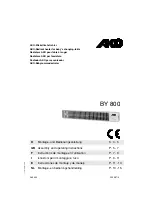
C E N T R I F U G A L H E A T E R - C S A
Chief Industries, Inc. 800-359-7600 OPERATION - 416274
Page 29
2.
Wet grain will remain relatively cool due to moisture evaporation from the kernel, however dry
grain will warm to the drying temperature.
3.
The drying front moves from the base of the bin upward. When operated as a batch system and
when a stirring machine does not reach the floor, significant over drying can occur at the base of
the bin.
4.
When drying grain and focusing on kernel quality, use as low a plenum temperature as possible.
Note: Do not automatically set the plenum temperature at the maximum
recommendation
.
5.
When the grain is nearly dry, reduce the plenum temperature to complete the drying. This will
reduce the quantity of cracked grain generated and reduce the fire hazard.
6.
When drying sunflowers, exercise caution because sunflowers are very flammable. Do not
exceed the temperature recommendations. Also, be aware that the chaff from sunflowers is
very flammable. Good housekeeping in the plenum chamber and around the bin is essential.
Recommended Drying Temperatures of Non-Seed Crops
Crop
In Bin Continuous Drying
Stir Drying
In Bin Batch Drying
Corn
160°F (71°C)
140°F (60°C)
120°F (49°C)
Grain Sorghum
160°F (71°C)
140°F (60°C)
120°F (49°C)
Wheat
140°F (60°C)
120°F (49°C)
110°F (43°C)
Rice
105°F (40°C)
100°F (38°C)
90°F (32°C)
Oats
140°F (60°C)
120°F (49°C)
110°F (43°C)
Sunflowers
110°F (43°C)
110°F (43°C)
100°F (38°C)
Soybeans
120°F (49°C)
120°F (49°C)
110°F (43°C)
Pinto Beans
100°F (38°C)
100°F (38°C)
100°F (38°C)
-
Note: Temperature recommendations are based on non-seed crops (to be marketed
commercially). For seed crops, do not exceed 110°F (43°C), except for pinto beans
do not exceed 100°F (38°C).
-
For other crops contact your extension service or Chief for drying temperature
recommendations.
















































